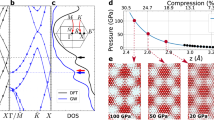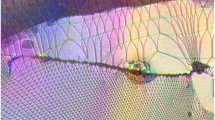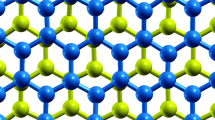Abstract
We derive and analyze a novel approach for modeling and computing the mechanical relaxation of incommensurate two dimensional heterostructures. Our approach parametrizes the relaxation pattern by the compact local configuration space rather than real space, thus bypassing the need for the standard supercell approximation and giving a true aperiodic atomistic configuration. Our model extends the computationally accessible regime of weakly coupled bilayers with similar orientations or lattice spacing, for example materials with a small relative twist where the widely studied large-scale moiré patterns arise (Kim et al. in Proc Natl Acad Sci 114:3364–3369, 2017; Yoo et al. in Atomic and electronic reconstruction at van der Waals interface in twisted bilayer graphene, Nat Mater 18:448–453, 2019). Our model also makes possible the simulation of multi-layers for which no inter-layer empirical atomistic potential exists, such as those composed of \(\hbox {MoS}_2\) layers, and more generally makes possible the simulation of the relaxation of multi-layer heterostructures for which a planar moiré pattern does not exist.




Similar content being viewed by others
Notes
A configuration is rigorously defined as the position of all atoms in the system relative to the origin, given an arbitrary translation of the system corresponding to a change of viewpoint, typically encoded as a Radon measure in \(\mathfrak {M}(\mathbb {R}^3)\). Formally, the hull is a dynamical system \((\Omega , \mathbb {R}^2, \mathtt {T})\) where \(\Omega \) is the closure of the orbit of the atomic distribution generated by the atoms of all p layers under the action of \(\mathbb {R}^2\) through \(\mathtt {T}\). Note that the group of translations \(\mathtt {T}_\mathbf {a}\) with \(\mathbf {a}\in \mathbb {R}^2\) acts on the space of compactly supported continuous functions \(\mathcal {C}_c(\mathbb {R}^3)\) naturally through \(\mathtt {T}_\mathbf {a}f(\mathbf {x}) = f(\mathbf {x}- \mathbf {a})\), and thus on the space of Radon measures \(\mathfrak {M}(\mathbb {R}^3)\) through \(\mathtt {T}_\mathbf {a}\mu (f) = \mu (\mathtt {T}_{-\mathbf {a}} f)\).
References
Aubry, S., Le Daeron, P.: The discrete Frenkel–Kontorova model and its extensions. I. Exact results for the ground-states. Physica D8, 381–422, 1983
Bellissard, J.: Coherent and Dissipative Transport in Aperiodic Solids. Lecture Notes in Physics, vol. 597, pp. 413–486. Springer, Berlin 2003
Bellissard, J., van Elst, A., Schulz-Baldes, H.: The noncommutative geometry of the quantum Hall effect. J. Math. Phys. 35, 5373–5451, 1994
Bezanson, J., Edelman, A., Karpinski, S., Shah, V.B.: Julia: a fresh approach to numerical computing. SIAM Rev. 59, 65–98, 2017
Blanc, X., Le Bris, C., Lions, P.-L.: Atomistic to continuum limits for computational materials science. ESAIM Math. Model. Numer. Anal. 41, 391–426, 2007
Cancès, E., Cazeaux, P., Luskin, M.: Generalized Kubo formulas for the transport properties of incommensurate 2D atomic heterostructures. J. Math. Phys. 58, 063502, 2017
Cao, Y., Fatemi, V., Demir, A., Fang, S., Tomarken, S.L., Luo, J.Y., Sanchez-Yamagishi, J.D., Watanabe, K., Taniguchi, T., Kaxiras, E., Jarillo-Herrero, P.: Correlated insulator behaviour at half-filling in magic-angle graphene superlattices. Nature556, 80–84, 2018
Cao, Y., Fatemi, V., Fang, S., Watanabe, K., Taniguchi, T., Kaxiras, E., Jarillo-Herrero, P.: Unconventional superconductivity in magic-angle graphene superlattices. Nature556, 43–50, 2018
Carr, S., Fang, S., Zhu, Z., Kaxiras, E.: Minimal model for low-energy electronic states of twisted bilayer graphene. 2019 arXiv preprint arXiv:1901.03420
Carr, S., Massatt, D., Fang, S., Cazeaux, P., Luskin, M., Kaxiras, E.: Twistronics: manipulating the electronic properties of two-dimensional layered structures through their twist angle. Phys. Rev. B95, 075420, 2017
Carr, S., Massatt, D., Torrisi, S.B., Cazeaux, P., Luskin, M., Kaxiras, E.: Relaxation and domain formation in incommensurate 2D heterostructures. 2018 arXiv preprint arXiv:1805.06972
Castro Neto, A.H., Guinea, F., Peres, N.M.R., Novoselov, K.S., Geim, A.K.: The electronic properties of graphene. Rev. Mod. Phys. 81, 109, 2009
Cazeaux, P., Luskin, M., Tadmor, E.B.: Analysis of rippling in incommensurate one-dimensional coupled chains. Multiscale Model. Simul. 15, 56–73, 2017
Ciarlet, P.G.: Linear and Nonlinear Functional Analysis with Applications, vol. 130. SIAM, Philadelphia 2013
Constantinescu, G., Kuc, A., Heine, T.: Stacking in bulk and bilayer hexagonal boron nitride. Phys. Rev. Lett. 111, 036104, 2013
Dacorogna, B.: Direct Methods in the Calculus of Variations, vol. 78. Springer, Berlin 2007
Dai, S., Xiang, Y., Srolovitz, D.J.: Twisted bilayer graphene: moiré with a twist. Nano Lett. 16, 5923–5927, 2016
Español, M.I., Golovaty, D., Wilber, J.P.: Discrete-to-continuum modelling of weakly interacting incommensurate two-dimensional lattices. Proceedings of the Royal Society of London A: Mathematical, Physical and Engineering Sciences, 474, 2018
Evans, L.C.: Partial Differential Equations. Springer Series in Computational Physics, 2nd edn. American Mathematical Society, Providence 2010
Geim, A.K., Grigorieva, I.V.: Van der Waals heterostructures. Nature499, 419–425, 2013
Gong, X., Mele, E.: Stacking textures and singularities in bilayer graphene. Phys. Rev. B89, 121415, 2014
Kim, K., DaSilva, A., Huang, S., Fallahazad, B., Larentis, S., Taniguchi, T., Watanabe, K., LeRoy, B.J., MacDonald, A.H., Tutuc, E.: Tunable moiré bands and strong correlations in small-twist-angle bilayer graphene. Proc. Natl. Acad. Sci. 114, 3364–3369, 2017
Kolmogorov, A.N., Crespi, V.H.: Smoothest bearings: interlayer sliding in multiwalled carbon nanotubes. Phys. Rev. Lett. 85, 4727, 2000
Marom, N., Bernstein, J., Garel, J., Tkatchenko, A., Joselevich, E., Kronik, L., Hod, O.: Stacking and registry effects in layered materials: the case of hexagonal boron nitride. Phys. Rev. Lett. 105, 046801, 2010
Massatt, D., Luskin, M., Ortner, C.: Electronic density of states for incommensurate layers. Multiscale Model. Simul. 15, 476–499, 2017
Nam, N.N., Koshino, M.: Lattice relaxation and energy band modulation in twisted bilayer graphene. Phys. Rev. B96, 075311, 2017
Novoselov, K.S., Geim, A.K., Morozov, S.V., Jiang, D., Zhang, Y., Dubonos, S.V., Grigorieva, I.V., Firsov, A.A.: Electric field effect in atomically thin carbon films. Science306, 666–669, 2004
Ortner, C.: A priori and a posteriori analysis of the quasinonlocal quasicontinuum method in 1d. Math. Comput. 80, 1265–1285, 2011
Ortner, C., Theil, F.: Justification of the Cauchy–Born approximation of elastodynamics. Arch. Ration. Mech. Anal. 207, 1025–1073, 2013
Prodan, E.: Quantum transport in disordered systems under magnetic fields: a study based on operator algebras. Appl. Math. Res. eXpress176–265, 2013, 2013
Su, X., de la Llave, R.: A continuous family of equilibria in ferromagnetic media are ground states. Commun. Math. Phys. 354, 459–475, 2017
Tritsaris, G.A., Shirodkar, S.N., Kaxiras, E., Cazeaux, P., Luskin, M., Plecháč, P., Cancès, E.: Perturbation theory for weakly coupled two-dimensional layers. J. Mater. Res. 31, 959–966, 2016
Van Koten, B., Ortner, C.: Symmetries of 2-lattices and second order accuracy of the Cauchy–Born model. Multiscale Model. Simul. 11, 615–634, 2013
van Wijk, M.M., Schuring, A., Katsnelson, M.I., Fasolino, A.: Relaxation of moiré patterns for slightly misaligned identical lattices: graphene on graphite. 2D Mater. 2, 034010, 2015
Vitek, V.: Intrinsic stacking faults in body-centred cubic crystals. Philos. Mag. 18, 773–786, 1968
Wen, M., Carr, S., Fang, S., Kaxiras, E., Tadmor, E.B.: Dihedral-angle-corrected registry-dependent interlayer potential for multilayer graphene structures. Phys. Rev. B98, 235404, 2018
Yoo, H., Engelke, R., Carr, S., Fang, S., Zhang, K., Cazeaux, P., Sung, S.H., Hovden, R., Tsen, A.W., Taniguchi, T., Watanabe, K., Yi, G.-C., Kim, M., Luskin, M., Tadmor, E.B., Kaxiras, E., Kim, P.: Atomic and electronic reconstruction at van der Waals interface in twisted bilayer graphene. Nat. Mater. 18, 448–453, 2019
Zhang, K., Tadmor, E.B.: Energy and moiré patterns in 2D bilayers in translation and rotation: a study using an efficient discrete–continuum interlayer potential. Extreme Mech. Lett. 14, 16–22, 2017
Zhou, S., Han, J., Dai, S., Sun, J., Srolovitz, D.J.: Van der Waals bilayer energetics: generalized stacking-fault energy of graphene, boron nitride, and graphene/boron nitride bilayers. Phys. Rev. B92, 155438, 2015
Acknowledgements
This work was supported in part by ARO MURI Award W911NF-14-1-0247 and by the National Science Foundation under NSF Award DMS-1819220.
Author information
Authors and Affiliations
Corresponding author
Additional information
A. Braides.
Publisher's Note
Springer Nature remains neutral with regard to jurisdictional claims in published maps and institutional affiliations.
Appendix A. Proof of Prop. 3.2
Appendix A. Proof of Prop. 3.2
In this appendix, we detail the technical proof of Proposition 3.2, which we recall first for ease of reading.
Proposition A.1
Let \(\mathbf {u}\in W^{2,q}(X)\), then
where  is the subset of the transversal corresponding to lattice sites of layer j, \(\nabla ^2_\omega \mathbf {u}_j\) is understood as a 2-linear form for which the norm is defined as \(\Vert \ell \Vert := \sup _{\vert \mathbf {h}_1 \vert = \vert \mathbf {h}_2 \vert = 1 } \left| \ell [\mathbf {h}_1, \mathbf {h}_2] \right| \) and
is the subset of the transversal corresponding to lattice sites of layer j, \(\nabla ^2_\omega \mathbf {u}_j\) is understood as a 2-linear form for which the norm is defined as \(\Vert \ell \Vert := \sup _{\vert \mathbf {h}_1 \vert = \vert \mathbf {h}_2 \vert = 1 } \left| \ell [\mathbf {h}_1, \mathbf {h}_2] \right| \) and
Proof
It is natural to relate this result to local finite element interpolant error estimation and follow similar steps. Let \(\omega \in \Omega \) be an arbitrary configuration, j be an arbitrary layer number. Consider a Taylor expansion up to degree 1 of \(\mathbf {u}_j\) around the point \(\Pi _j\omega \):
Using the integral formula for the residual of the Taylor series, we have
so by Jensen’s inequality we obtain the estimate
As earlier (see (3.2)), let us write \(\varvec{\gamma }_j = \mathrm {E}_j \begin{bmatrix} s \\ t \end{bmatrix}\) with \(0 \leqq s, t < 1\). The lattice sites in layer j around the origin are located at the four points \(\mathbf {r}_{ab}\) with \(a, b \in \{ 0,1 \}\) defined as in (2.12). One checks easily from the definition (3.4) that
where the shifts \(\delta \omega _{00}\), \(\delta \omega _{10}\), \(\delta \omega _{01}\), \(\delta \omega _{11}\) can be chosen as
since \(\delta \omega _{ab}\) is defined on \(\Omega \) and is thus invariant under lattice shifts. Note that for \(a,b \in \{0,1\}\),
where \(\theta \) is defined in (3.6). Furthermore, the weighted average of these shifts is zero:
where we have introduced the bilinear weights
As a consequence, by the affine character of the Taylor approximant \(T_\omega ^1 \mathbf {u}_j\) defined above,
Let us now rewrite the definition (3.2) of the bilinear interpolant \(\widetilde{\mathbf {u}}_j\) as
Taking the difference of the identities (A.4), (A.5) and using convexity of the norm and the above Taylor estimate (A.3), we find the pointwise estimate
We may now integrate over the configuration parameter \(\omega = (\varvec{\gamma }_1, \ldots , \varvec{\gamma }_p)\). The difference between \(\omega \) and \(\left( \Pi _j \omega + h \delta \omega _{ab}\right) \) depends only on s, t and h, for example
Integrating over the variables \(\varvec{\gamma }_i\) for \(i \ne j\) with fixed values of \(\varvec{\gamma }_j= \mathrm {E}_j \begin{bmatrix} s \\ t \end{bmatrix}\) and h we find that by translation invariance of the Lebesgue measure,

This leads to

Since the right-hand side does not depend on the remaining variable \(\varvec{\gamma }_j\), one last integration over it yields
which proves the desired estimate (3.5). \(\quad \square \)
Rights and permissions
About this article
Cite this article
Cazeaux, P., Luskin, M. & Massatt, D. Energy Minimization of Two Dimensional Incommensurate Heterostructures. Arch Rational Mech Anal 235, 1289–1325 (2020). https://doi.org/10.1007/s00205-019-01444-y
Received:
Accepted:
Published:
Issue Date:
DOI: https://doi.org/10.1007/s00205-019-01444-y




